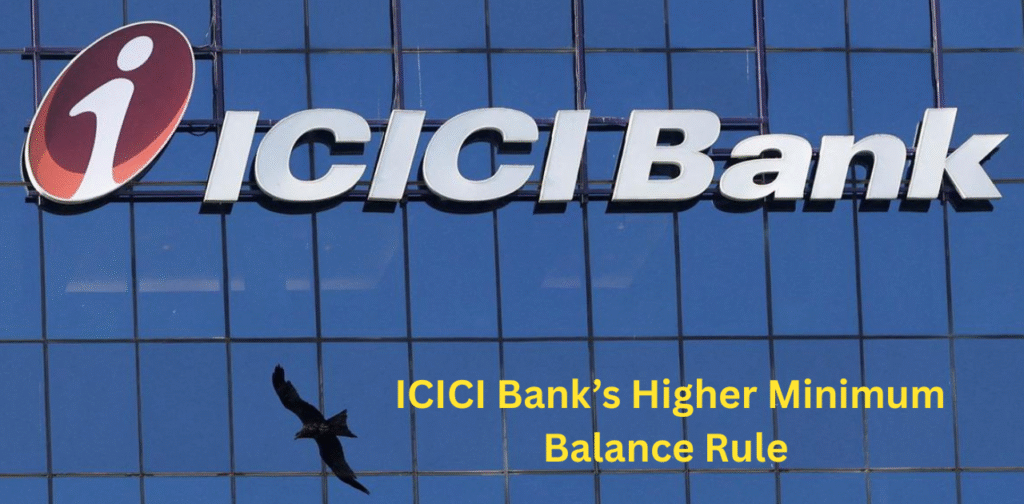New Delhi, August 9, 2025 — ICICI Bank has sharply raised the minimum average balance requirement for new savings accounts, a change that’s set to affect thousands of customers across the country.
Starting on August 1, people who open new accounts in cities and metro areas must retain an average balance of ₹50,000, up from the previous ₹10,000. In semi-urban branches, the minimum amount has gone up from ₹5,000 to ₹25,000. For accounts in rural areas, it has gone hiked from ₹2,500 to ₹10,000
📉 Impact on Rural and Semi-Urban ICICI Customers
ICICI customers in rural and semi-urban areas are likely to feel the most impact from the shift.
Customers who struggle to maintain the higher balance might end up paying extra charges, putting more strain on their finances. For other people, this might be the last straw, and they might switch to banks with better terms or start a basic savings account that doesn’t require a minimum amount. Some people may need to be more careful with their money to stay inside the new restrictions and avoid extra fees.
🏦 Different Approach from Government Banks
The decision comes at a time when some government banks are scrapping or easing their minimum balance rules to attract more customers. ICICI Bank, however, has taken a different path — one that analysts say could reshape its customer base but may also alienate smaller account holders.
📌 New Minimum Balance Rules
For accounts opened after August 1, the monthly average balance requirements are as follows:
Metro & Urban branches: ₹50,000 (previously ₹10,000)
Semi-Urban branches: ₹25,000 (previously ₹5,000)
Rural branches: ₹10,000 (previously ₹2,500)
The MAB is calculated on the average of day-end balances during the month. For existing customers, the earlier limits remain unchanged — ₹10,000 for metro/urban branches and ₹5,000 for semi-urban and rural branches.
💸 Penalty for Falling Short
If the required MAB is not maintained, customers will face a penalty of 6% of the shortfall or ₹500, whichever is lower. These charges will not apply if the account qualifies under the bank’s enrolled program.
In Family Banking, members collectively must maintain 1.5 times the MAB eligibility; if not, non-maintenance charges will apply to individuals who miss their own target. Pensioners are fully exempt.
📊 Other Banking Charges Updated
The bank has also adjusted several other service fees:
ECS/NACH debit returns due to insufficient funds: ₹500 per instance, with a limit of three per month for the same mandate.
Outward cheque returns (financial reasons): ₹200 per instance.
Inward cheque returns: ₹500 for financial reasons, ₹50 for non-financial reasons (excluding signature mismatch).
Declined ATM/POS transactions due to low balance: ₹25 per instance.
Cash deposits or withdrawals: First three free each month across branches or Cash Recycler Machines; ₹150 per transaction thereafter.
💬 Customers Push Back
Social media has been buzzing with criticism since the announcement. Many users argue that the change is unfair to those with limited income and could push them away from formal banking.
“Why would an average person keep ₹50,000 idle in a savings account? Imagine the interest loss! This is just unreasonable,” one post read.
“Government banks are making banking easier, but private banks are raising the bar. This is the downside of privatisation,” another user commented.
Some have even urged the Reserve Bank of India (RBI) to step in, calling the hike discriminatory and unnecessary.
📈 Why the Change Now?
Banking experts say that a few things could be behind this move:
Paying for the higher costs of conducting branch operations and keeping digital banking technology up to date.
Changing the focus to getting and keeping a more high-end group of customers.
Building up greater deposit buffers to help with lending and future investments.
But there’s a trade-off. Financial consultant Ramesh Vaidya points out that while this might improve the bank’s average deposit size, it could also drive away middle-class and rural customers — especially when zero-balance digital banking options are growing in popularity. Also Read
⚖️ What This Means for Customers
This reform is part of a wider transformation in India’s banking system:
Banks in the public sector are heading toward accounts that don’t need much or any minimum balance.
Digital-first banks are winning over younger customers by offering accounts with no minimum balance at all.
Private banks, on the other hand, are going for high-value account holders, even if it means losing some smaller customers.
If you wish to open a new account with ICICI Bank, you need to carefully consider your options. Those who may find it difficult to maintain the higher MAB might consider switching to a Basic Savings Bank Deposit Account (BSBDA) or exploring banks that have lower minimum balance requirements.

